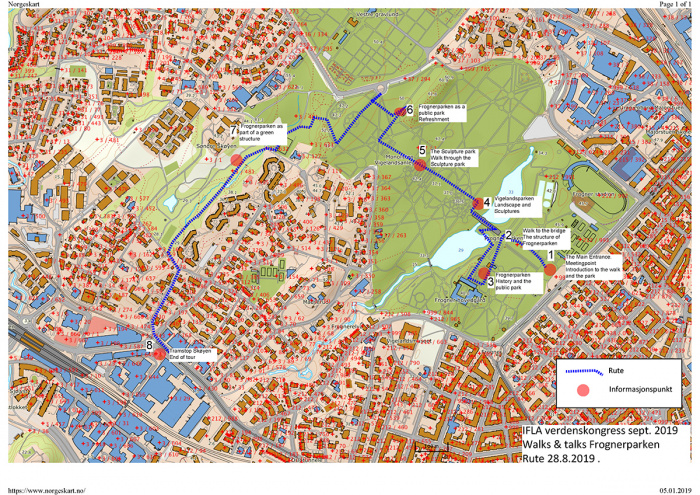Walks+Talks: Frogner + Vigeland Park
Frognerparken with adjacent green structure is probably Norway's most famous park with Gustav Vigelands sculpture park as a key motive. The city walk will explain how the park is a unique tourist destination with a huge number of visitors. At the same time, it is the most important recreational area in the western part of Oslo. The park's cultural and landscape history is important for understanding its design.
Entrance of the park
It is an important distinction between Frognerparken as a “ordinary” public park, and the sculpture park west of the stream and the pond. The first traces of a park were a baroque garden created in the 17th century. The City of Christiania (Later named Oslo) bought the area in 1896.
On the grounds of the 1914 centenary exhibition for the Norwegian Constitution of 1814, and the former 18th century baroque garden, the park administration of Oslo, headed by landscape architect Marius Røhne, was given the task to design a public park. Professional like Marius Røhne and professor Olav Moen strongly disagreed in the park design proposed by sculptor Gustav Vigeland
The sculpture park was designed as a strong axis leading from the entrance trough several main motives, by the sculptor himself, with the help of garden architect Josef Oscar Nickelsen. The main goal of the design of this part of the park was to give space for acollection of more than 200 sculptures by the artist Gustav Vigeland (1866 – 1943), donated to the city of Oslo.
The park is nonetheless the most popular park in Oslo, with well over a million visitors per year. The sculpture park is an international attraction. At the same time Frognerparken and its connection with the green structure of the part of Oslo, offers an important recreational area for the citizens of Oslo including space for a large number of organized and free activities. The tour will explain the park structure, introduce you to the sculptures of Gustav Vigeland and offer an analysis of the historical landscape layers of the park.
General information about park and the overall concept of the park. The Municipality of Oslo bought Frogner hovedgård in 1896. Brief information about the development of Oslo as a city “from “fields” to urban structure. About the National exhibition 1914 (Norwegian constitution 100 years in 1914).
Bridge
This part of the park is an enormous exhibition of art and as such one of the biggest tourist attractions in Oslo. At the same time, Frognerparken with the areas surrounding the sculpture park is an important public recreational area for the citizens of Oslo. During the walk we will look at the correlations and the contrast between the public park and the sculptures.
The overall design of the park resulted in heavy discussions between Gustav Vigeland and the professional landscape architects at the park administration of Oslo, headed by Marius Røhne. This discussion will be illustrated in a tableau.
On the occasion of the ‘double jubilee’ – 150 years since the birth of Norway’s greatest sculptor, Gustav Vigeland, and 100 years since the first university programme in landscape architecture was established in Norway (and Europe!), the first part of the Frogner walk will stage the debate between first professor of garden art, Olav Moen, and the sculptor Gustav Vigeland himself. Prof. Moen engaged in the public debate in both professional and social issues. In 1930’ies he was involved in the discussion about the establishment of Vigeland’s sculpture Park in Oslo. A huge public area was dedicated to the display of Vigeland’s sculptures, and the artist was given ‘free hands’ in the design of the area. Vigeland presented a park plan without consulting any landscape architects, and the result, which was accepted by the City Council without discussion, caused outrage. Olav Moen was; one of the sharpest critics, quoted in all the main newspapers: «No other European city would even consider building anything as bad as this» he said. In the performance, the alternative plans are shown, and the debate concludes in an agreement between the two opponents: time has shown that the park has become success after all.
Frognerparken as a public park
100 year as a public park, challenges and opportunities. Frognerparken is a part of an overall green structure including “The English park, Nordjordet og Vestre gravlund.
A green structure
We will walk on the edge between the “green” landscape and residential areas build in 1970s on the premises of landscape qualities. Meeting the heavy city transformation of industrial sites to urban areas at Skøyen.
IFLA World Congress 2019 will take a closer look at urban transformation, green mobility, healthy and beautiful landscapes and community participation. During three days in Oslo, we aim to inspire, challenge and intrigue you. We want you to share and reflect on the knowledge that is developed, presented and discussed.
Join us in moving one step further to understand and protect our COMMON GROUND.
This article is part of IFLA Common Grounds: Walk+Talk.
You can view all Walks+Talks tours here


